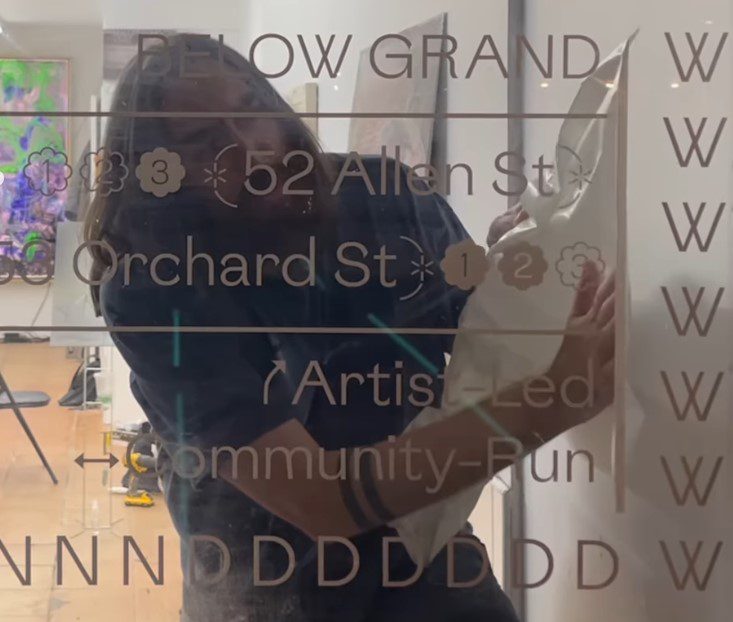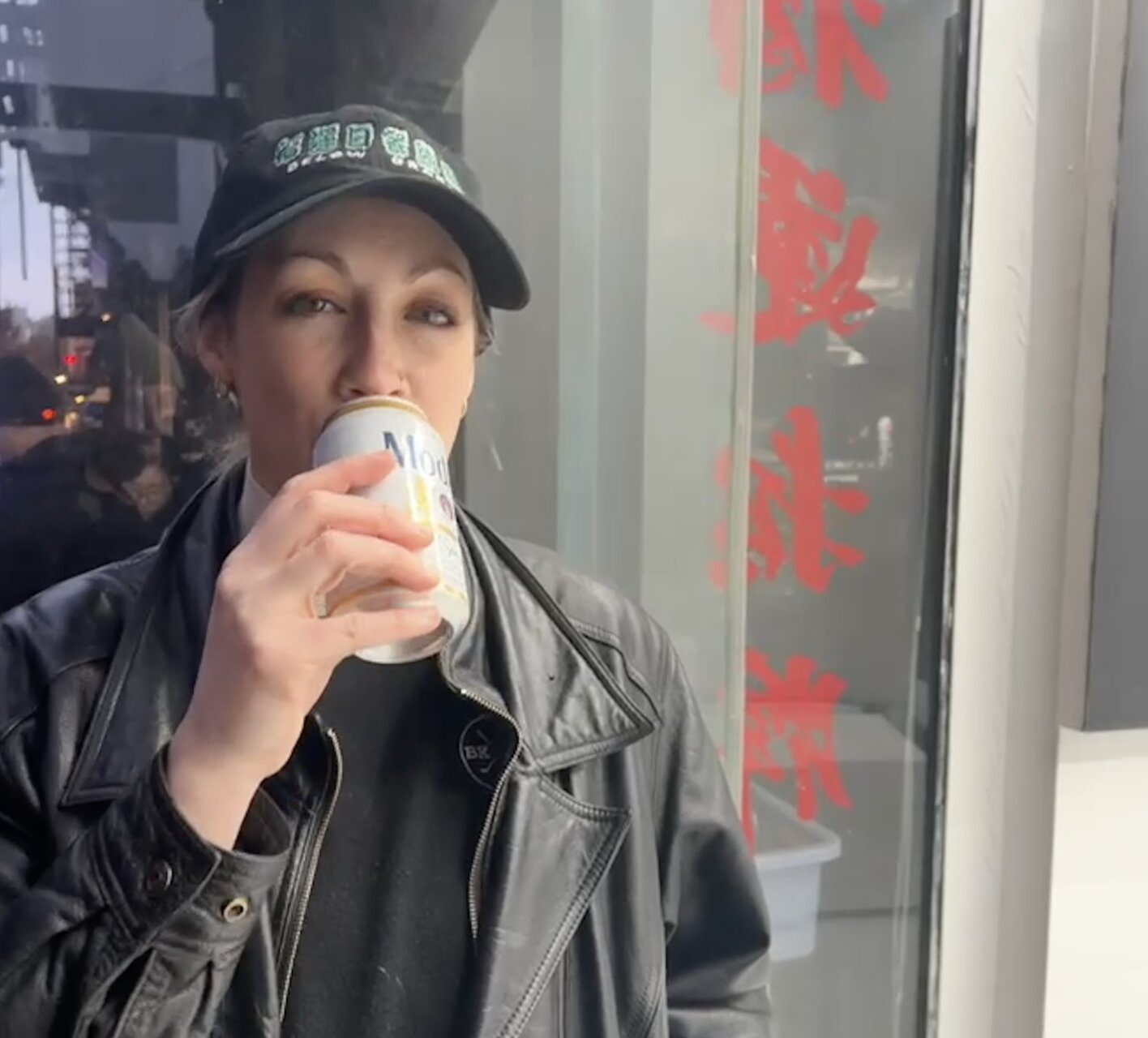Below Grand members Andrew Woolbright, Mo Kong, Marco Tulio, Aparna Sarkar, and Marissa Graziano in conversation with Irini Miga for Daily Lazy
Tucked within the vibrant streets of New York City’s Chinatown, Below Grand is redefining what it means to run an art space today. Founded on principles of creativity, generosity, resilience, and deep solidarity, this artist-run gallery is thriving—ethically and collectively—in one of the world’s most competitive art scenes. Operated by a rotating cohort of 24 members, the gallery is a living example of radical togetherness, rooted in mutual support and transparent collaboration. Irini Miga spoke with five of its current members—Andrew Woolbright, Mo Kong, Marco Tulio, Aparna Sarkar, and Marissa Graziano—about what it takes to sustain a space like this, and what it means to build community through art in 2025. Their reflections reveal an inspiring model for an alternative art ecosystem—one that challenges conventional norms and imagines bold, collective futures for creative autonomy.
 Complete Metamorphosis, Wiley Guillot, Bryce Kroll, Kaito Itsuki, Daffy Scanlan, Stefan Schwartzman, Blair Whiteford, Curated by Francisco Correa Cordero, Lubo, Aug 14 – Sept 22, 2019, Below Grand, 53 Orchard St, NY.
Complete Metamorphosis, Wiley Guillot, Bryce Kroll, Kaito Itsuki, Daffy Scanlan, Stefan Schwartzman, Blair Whiteford, Curated by Francisco Correa Cordero, Lubo, Aug 14 – Sept 22, 2019, Below Grand, 53 Orchard St, NY.
Irini Miga: How and when did Below Grand form? What inspired its creation?
Andrew Woolbright: I remember a critic in Chicago telling a group of us that it was a city that no one paid attention to, and that was its strength. We were told if we had a spare room or a spare closet we should make a playlist, invite people over, and turn it into a gallery and start showing people.
As an artist, it comes down to are we a part of making power more abstract, or are we demystifying it? Are our actions saying “you should want to be me? You should desire what I have?”or do we all stop building into that desire production of capitalism and helping each other instead. Artists have a responsibility to correct the record. Without artists, history would just be an extended narrative of the market and institutional acquisition. We only know about Louise Bourgeois and Paul Thek and Bob Thompson and Alice Neel and a host of others because artists wouldn’t stop talking about them. I think we become artists when we start saying the names of artists that people don’t already know.
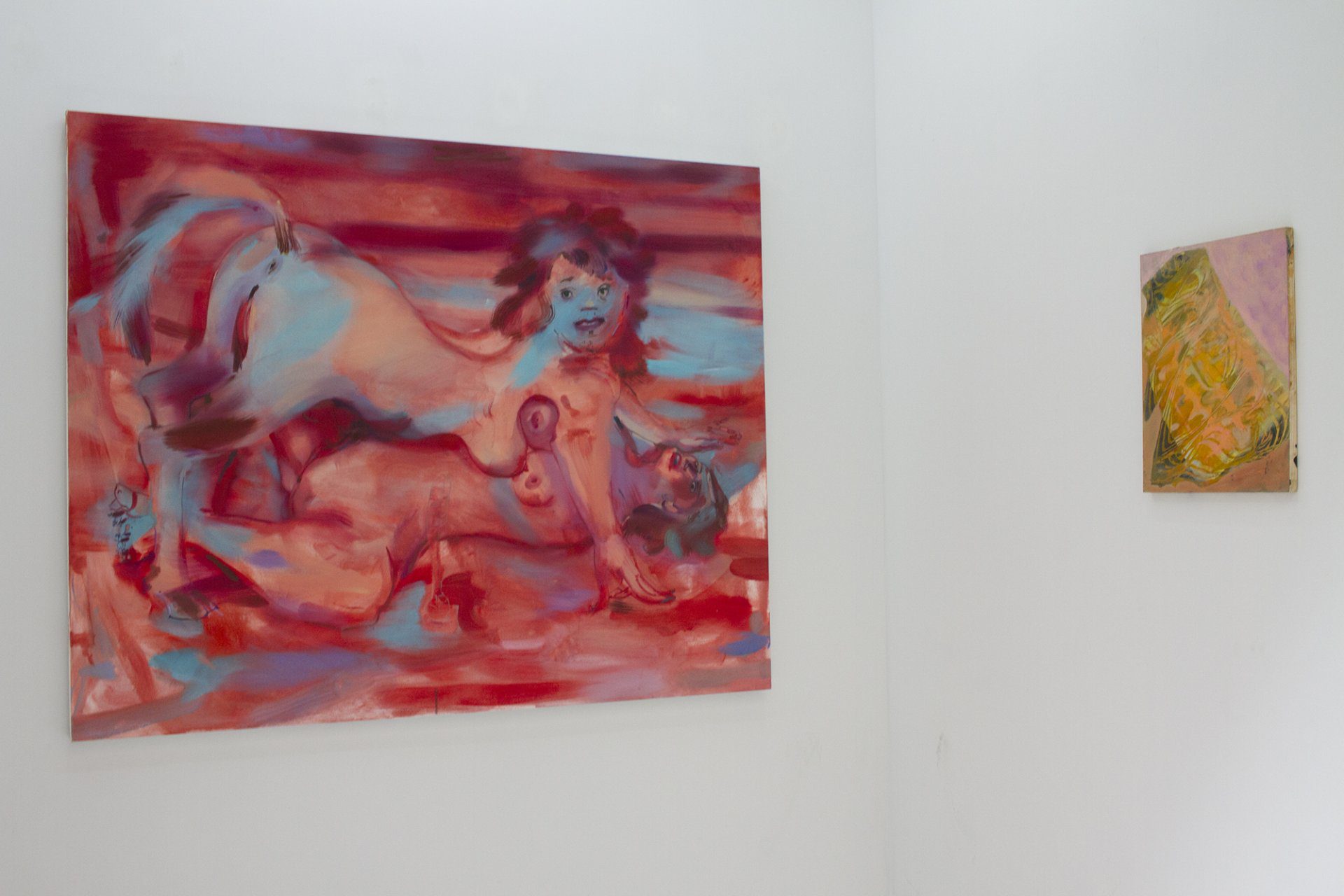 Menage/rie, Angela Dufresne, Lauren Fejarang, Daniel Giordano, Kathy Goodell, Andrew Woolbright, February 4 – April 8, 2018, Below Grand, 53 Orchard St, NY.
Menage/rie, Angela Dufresne, Lauren Fejarang, Daniel Giordano, Kathy Goodell, Andrew Woolbright, February 4 – April 8, 2018, Below Grand, 53 Orchard St, NY.
I was running a space upstate called Karst and Gorse out of my studio. Daniel Giordano heard about the window and we started planning the first show. In the beginning I asked Lauren Fejarang, Kathy Goodell, Kyle Hittmeier, and Amanda Nedham to join, and Amanda and Kyle knew Kate McQuillen and invited her. The gallery wouldn’t be what it is today without all of the work Lauren put into it. She’s an incredible sculptor and has a great eye for what is being made that feels new and relevant. Her and Kyle and Amanda stayed on for a long time and helped steer things through covid and after. Angela Dufresne said yes to being in that first show and everyone in the second show said yes because we showed her. I learned a lot from that. The space doesn’t matter. Artists only care about who else has shown there. It’s about community trust. And also, part of being an artist is using your reputation to grow spaces. Below Grand, New York.
Mo Kong joined in year 3 and things got really solid from that. They’re a brilliant sculptor, brutally honest, incredibly critical and decisive. We are fortunate in that we’ve never been exhausted at the same time. It’s important to have someone who’s hot when you’re cold and cold when you’re hot. I think alignment in a gallery is a careful balance. Everyone being too aligned in their thinking can be as dangerous as no one being able to agree on anything. Whatever you create, you need that other person that you can look across at and say “I’m in it as long as they are.”
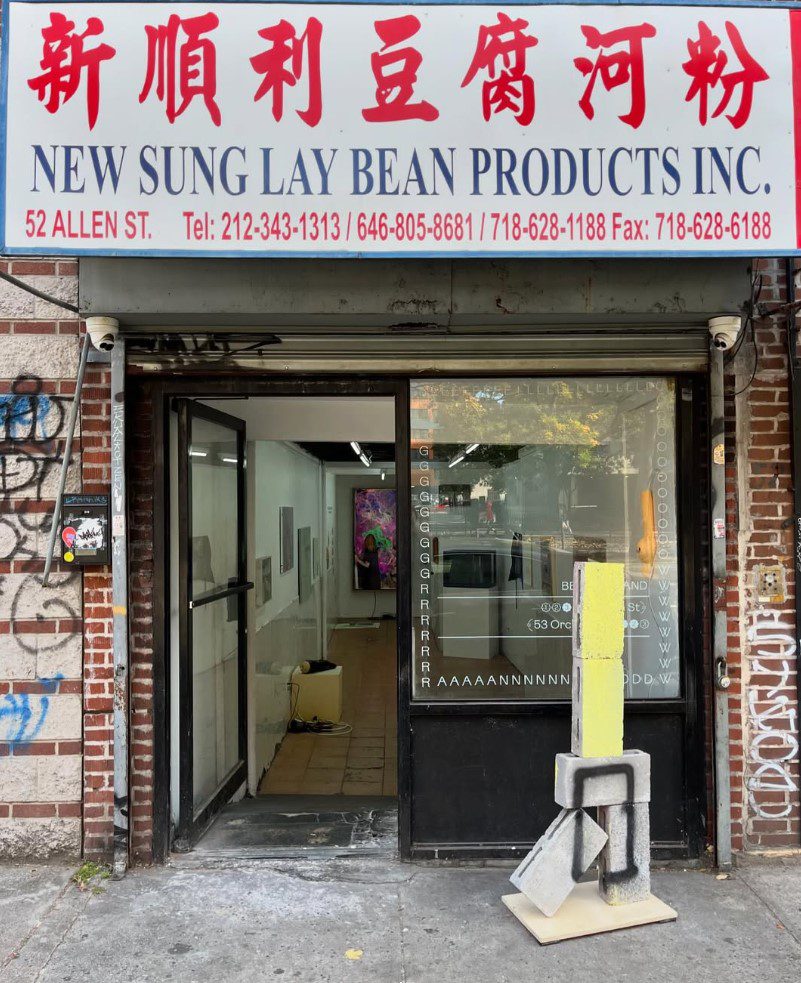 MERIDIAN, October 12 – November 16, 2024, Below Grand, 52 Allen St, NY.
MERIDIAN, October 12 – November 16, 2024, Below Grand, 52 Allen St, NY.
Mo Kong: After I joined the team, we experienced two times of expanding. First time this happened during COVID-19, when every gallery temporarily closed and skipped shows, our window has been proudly open 6 days/week, since it is low maintenance, it opens when the store opens. At the end of 2021, our landlord needed some financial support. We took a section of their interior storage space, then opened the second small space. It met the quateires the window space doesn’t have. We started to do more video projection, events in this dark backdoor gallery. The second growth of the gallery was in 2024, I got a call from our landlord directly, they are looking for someone to take over the space next door formerly known as New Sung Lay Bean Products inc. (Actually we still keep their sign as part of our logo). After a brief meeting, we built the current Below Grand team.
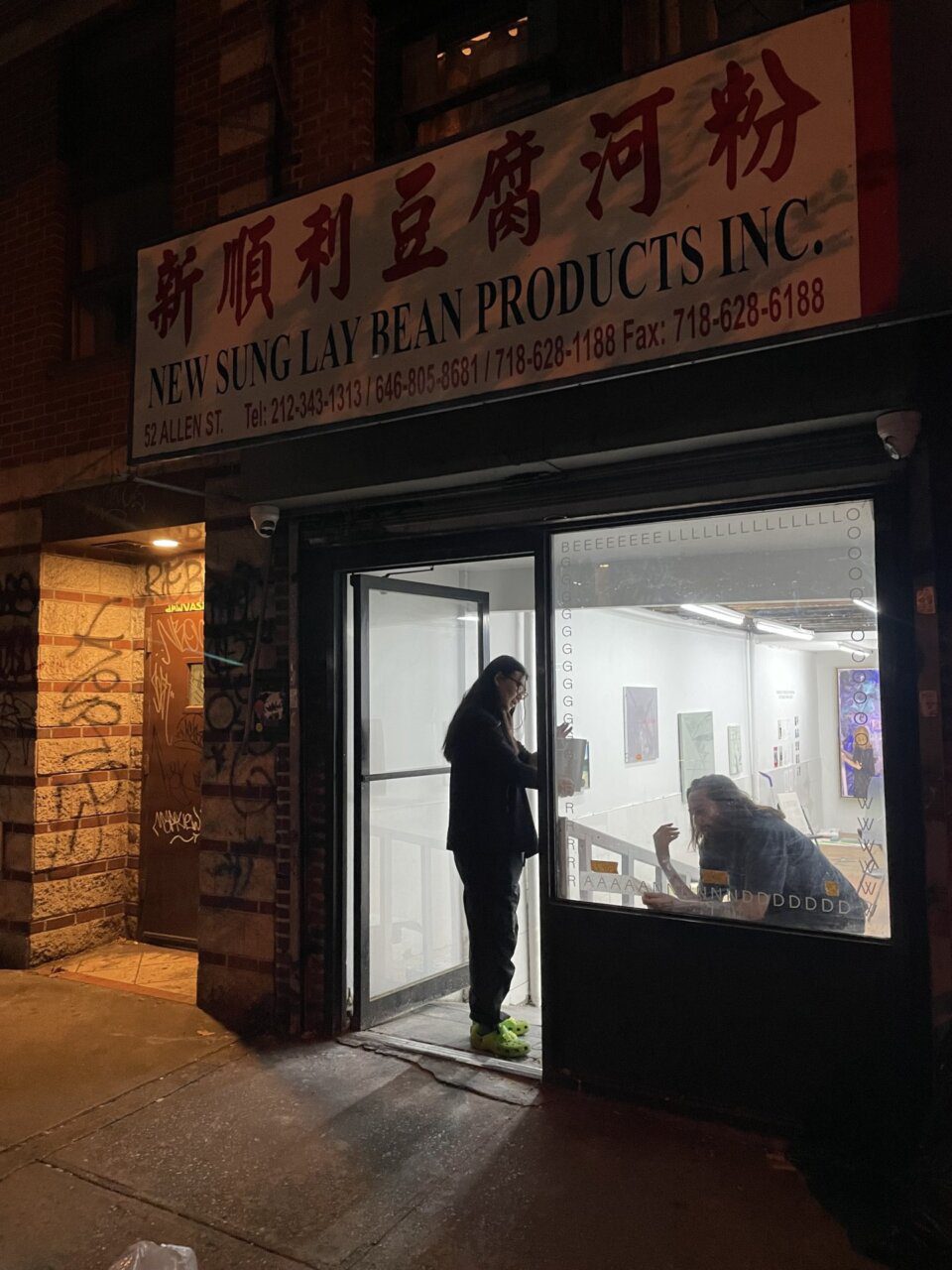 Mo Kang (left) and Andrew Woolbright (right and below), Below Grand, 52 Allen St, NY.
Mo Kang (left) and Andrew Woolbright (right and below), Below Grand, 52 Allen St, NY.
IM: What are some of the challenges of running an artist-run space like yours in a city like New York? How do you overcome them?
AW: I think most people don’t realize how much work it is. I think for the most part, it should be thought of closer to volunteer work than a career. A lot of people think that you run a space until you get successful, or if you run a space that that must mean that you’ve failed at something else, or you’re making money off of it. It’s a kind of irony in New York that if you help too much there are people that will interpret that as an expression of weakness or lacking something. There are artists that start spaces to promote themselves through it. But we really look for people to join who know a lot of people that they want to advocate for, who come in with a list of artists that they think should be showing more often than they do. We all think it’s necessary.
There’s a whole history of artists running spaces–from the 10th Street Galleries and on. A A lot of great artists get frustrated because they know so many under-recognized artists and want to do something for them. Alex Katz, Yoko Ono, Howardena Pindell, Jenny Holzer, Peter Doig, R.H. Quaytman, Andrea Fraser, all were part of artist-run gallery co-ops. It’s more an indictment that people see community building and anything that tries to function outside of transactional capitalism as a form of failure. I’m happy to demystify and disappoint any idea of an artist having a “career.”
Marco Tulio: Square footage in a city like New York can be challenging to find at a reasonable price. But Below Grand has managed to thrive from starting out with a window display smaller than those allotted to Bergdorf Goodman luxury store. But every now and then you hear of those feel-good successful street vendor stories, where the seller provides exceptional exquisite flavors and they are forced to expand. Well, Below Grand is no Halal Guys, but a group of artists who thoroughly believe in the power of artists supporting artists. From an intimate window display, to another gallery space right behind the window, to currently manning a third space with a graffiti-covered gate shielding our newest expansion, we continue to grow. Real estate here builds up, while Below Grand expands horizontally, both physically and structurally.
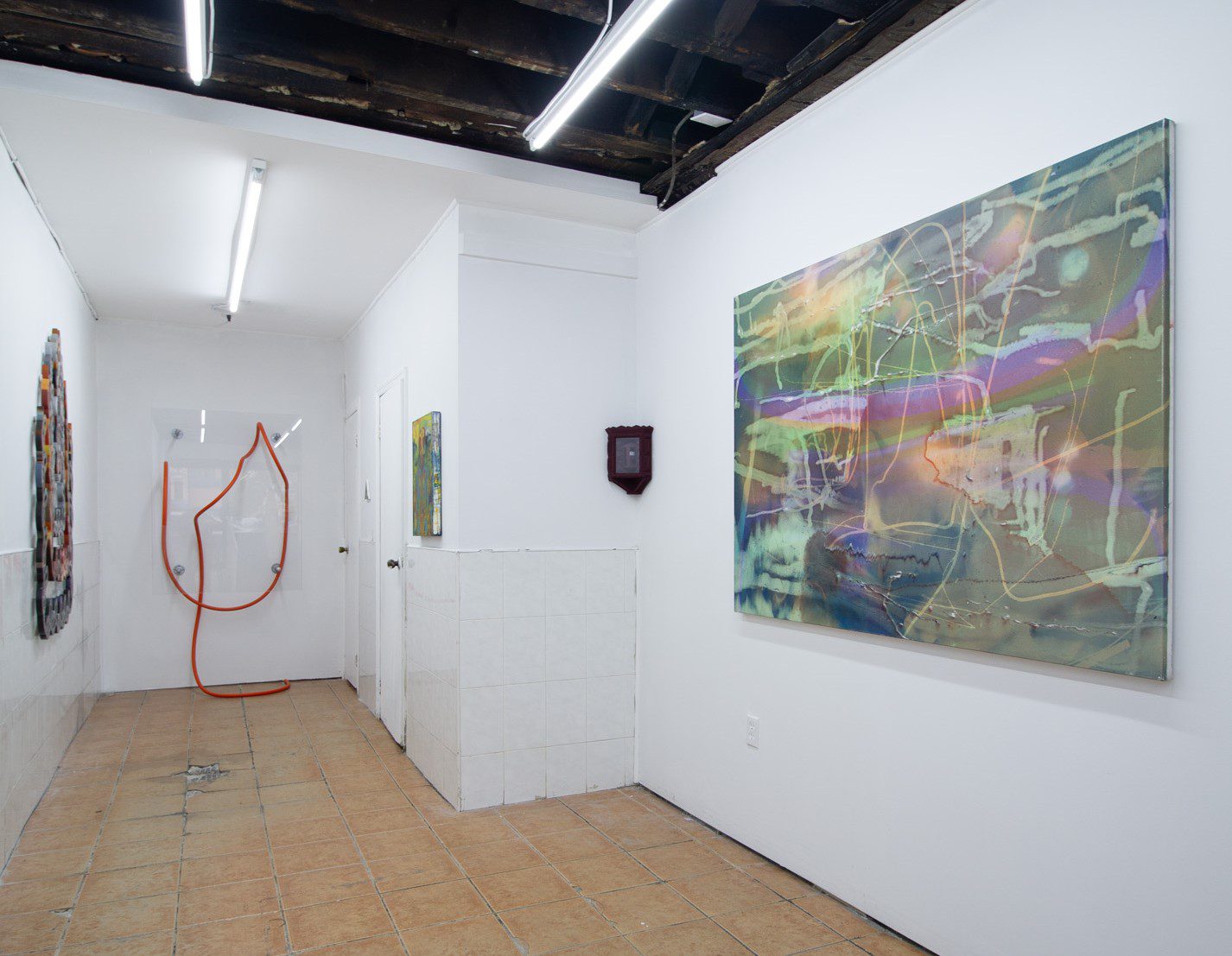 Channels, Blinn & Lambert, Norton Wisdom, Mack Sikora, Clinton King, James Miller, Mike Olin, Loretta Violante, Rochelle Voyles, Sharon Cheuk Wan Lee, Richard Tinkler, Drew Kohler, Eva Robarts, & Kim Farkas, Curated by Marco Tulio de la Sierra, Nov. 23 — Dec. 27, 2024, Below Grand, 52 Allen, NY.
Channels, Blinn & Lambert, Norton Wisdom, Mack Sikora, Clinton King, James Miller, Mike Olin, Loretta Violante, Rochelle Voyles, Sharon Cheuk Wan Lee, Richard Tinkler, Drew Kohler, Eva Robarts, & Kim Farkas, Curated by Marco Tulio de la Sierra, Nov. 23 — Dec. 27, 2024, Below Grand, 52 Allen, NY.
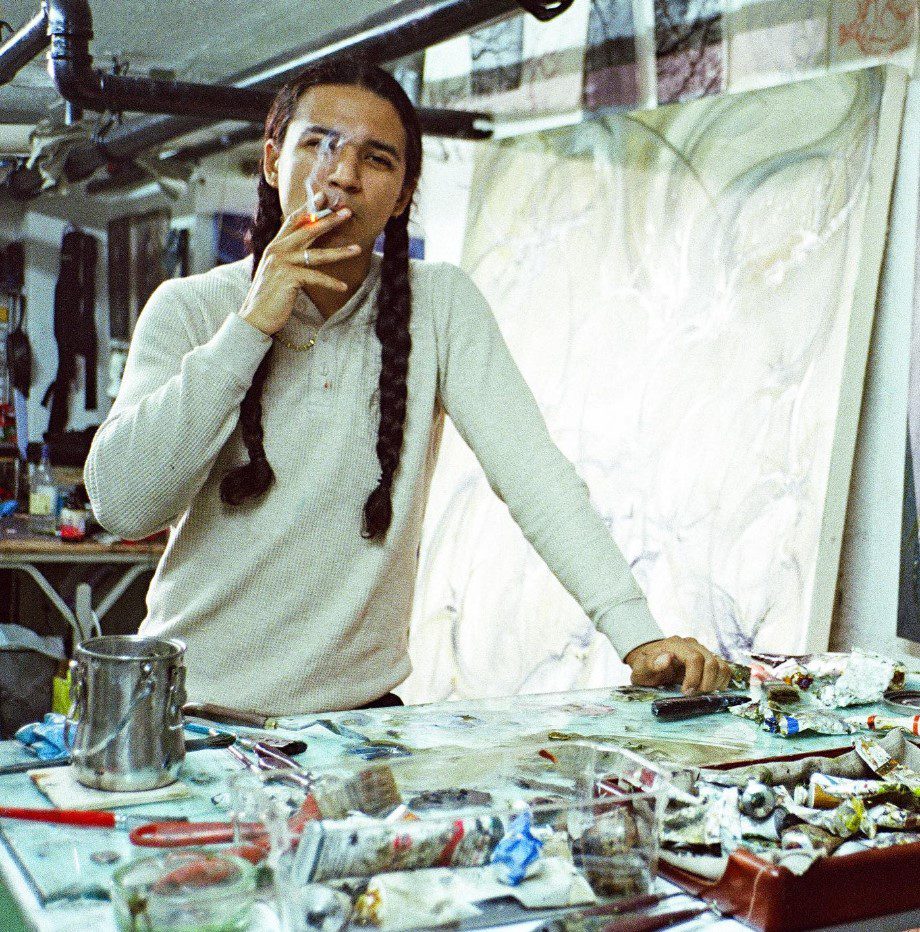 Marco Tulio de la Sierra (above), studio portrait, 2025.
Marco Tulio de la Sierra (above), studio portrait, 2025.
AW: It is the eternal problem of being an artist that it is very difficult to get started. I think a lot of the galleries that do open calls are just scamming people. There’s a lot more money in being a landlord than a gallerist, and sometimes I think the people charging artists to show in New York are the only ones making money. It is difficult to get a show in New York with rent and costs being what they are if you don’t make work that follows a certain idea of what work should look like. There are very few gallerists that can afford to risk the future of their space or their own stability for an artist they don’t know. Because of how we work, we can show people that advance art as a philosophy or a form of poetics more than a commodity, and if we can get them a review or place their work with someone, sometimes bigger spaces will bite and show them next. It’s a system that keeps us perpetually in the minor leagues, but it’s all that interests us.
Aparna Sarkar: Coordinating between all 24 current members–getting everyone in the room, on board with an idea, involved—this is an obvious challenge, though not as hard as I would have anticipated it being. The gallery is each member’s seventh or tenth responsibility, among various jobs and practices. So when logistics fall through the cracks, we operate well on continuous grace and generosity, always assuming the best of each other. Andrew, Mo, and Marco have modeled this compassion since I joined the gallery a little over a year ago. We also created some structure when we expanded from 10 to 24 members last fall; for example, there’s an exhibition committee that meets to review shows with curators starting six months out. All of our committees and roles are self appointed–whoever wants in on a responsibility is welcome to it. And, we have people right now who can do everything: art handling, design, construction, AV, contracts, contacts… ! In our meetings, I’ve been impressed with the balance of honesty/discernment with respect for difference in opinion. I think this means we’re choosing members well.
IM: What makes the New York art community unique, and how does your space contribute to that identity?
AW: I only know New York so I don’t know how it compares. I like Jan Ver Woert’s essay on Angelic Hosting, and I think about how much invisible effort goes into hosting and creating a space. I think a lot of people run spaces because they want credit, and that doesn’t work here. People can immediately identify if you’re running a space to bring attention to your own practice. People pay attention to spaces that are artist-led that eventually the artists give themselves shows or fair booths. I think we have the reputation that we do because we make every effort to show up and then fade back.
We love when we give someone their first show and it leads to a studio visit from someone that can really change their life. An older gallerist once told me that there are two types of gallerists: those with eyes and those with ears. He said Below Grand has eyes, and the eyes don’t always make money like the ears can. I’d rather be known for trying to address significance in new ways–– trying to see significance in places that are being overlooked.
MT: I moved back to New York City a couple of years ago after spending a considerable amount of time in both Los Angeles and the Bay Area. And while I miss the west, it could not possibly replace the artistic grit and community found in New York. Every artist I know here has this immeasurable drive for creating, experimenting, sharing, and surviving. Artists here are juggling multiple jobs, social lives, and steady studio practices. Priorities vary, but what stays constant is that work is being made and shown. I have met public school teachers nearing retirement, parents, bartenders, art handlers, and so forth who are still maintaining a steady studio practice. Those are the gems that make living and working in New York City all worth it. And within this city I am fortunate enough to share and continue growing a space with a pack of like minded individuals who continue to curate wildly diverse and exciting shows.
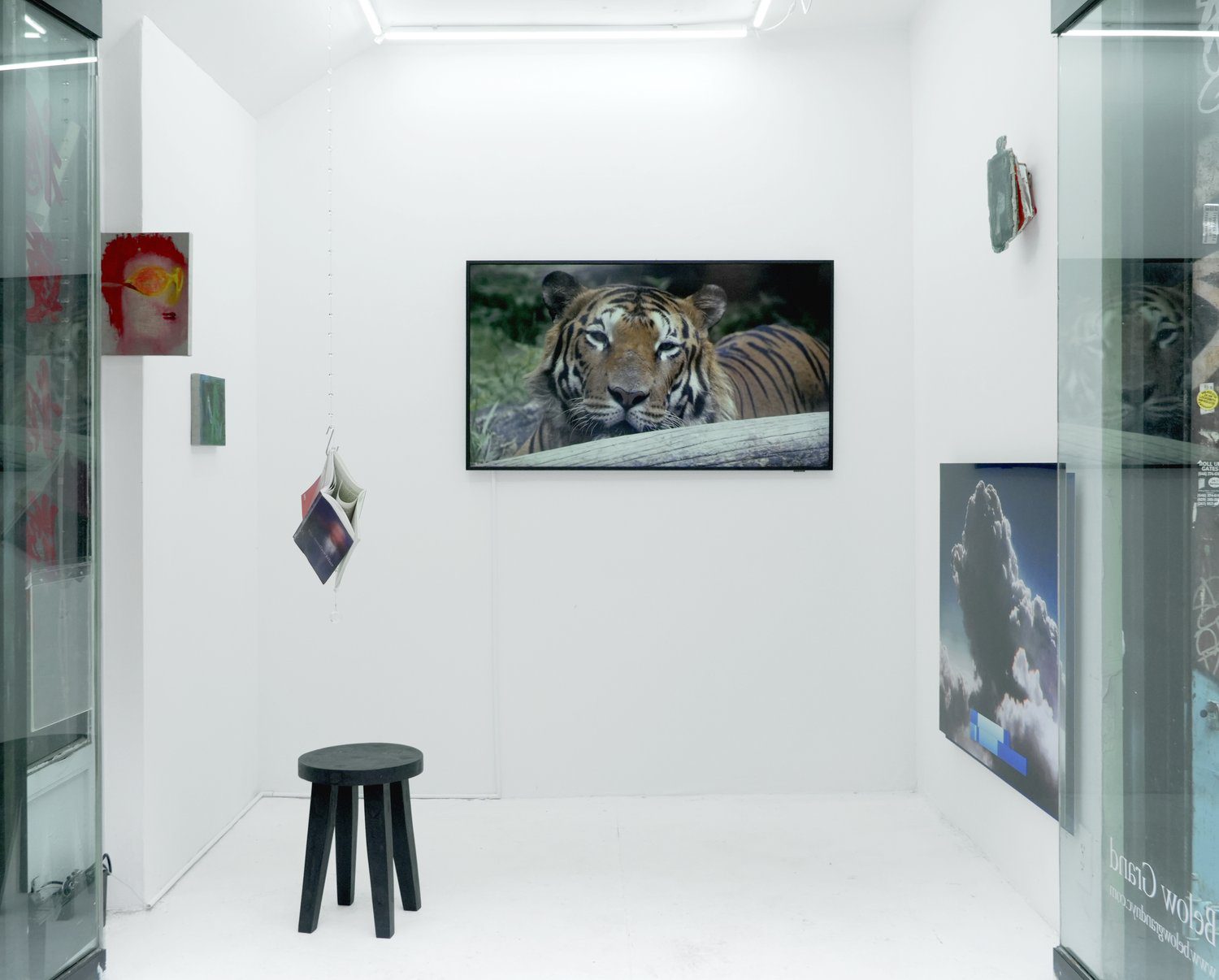 Interface of the Abyss, aaajiao, Chando Ao, Hyunseon Kang, Kelvin Kyung Kun Park, Mark Dorf, Yi Xin Tong, Curated by Frank Wang Yefeng, August 31 – October 25, 2024, Below Grand, 53 Orchard St, NY.
Interface of the Abyss, aaajiao, Chando Ao, Hyunseon Kang, Kelvin Kyung Kun Park, Mark Dorf, Yi Xin Tong, Curated by Frank Wang Yefeng, August 31 – October 25, 2024, Below Grand, 53 Orchard St, NY.
AS: If you live in New York and aren’t going to events, doing things with other people, being in community––it makes no sense to live here. We all feel that, especially and emphatically as artists. Also: the NY art scene is walkable! This is major, and LA could never. Proximity of galleries to one another is one of my favorite things about being an artist in NYC; going to see shows means seeing each other, as we all snake our way through so many galleries in one day or evening. Shows are consolidated by neighborhood. Where we are, in Chinatown alone, there are plenty of galleries, with more cropping up all the time and Tribeca a short walk away. And from there, let’s be honest, Chelsea’s not far.
MK: Galleries in the Lower East Side are different from galleries in other neighborhoods. We are conscious and mindful of the space we took, especially close to chinatown. We refuse to turn the neighborhood to another gentrified area, I think that makes us unique. Our gallery has a healthy symbiotic relationship with our landlord. You can go through the kitchenware store to the gallery spaces, we often see people buying dishes during our openings. The acceptance gave us an unique identity, yes we are part of the NYC art scene, more important we are part of the local Chinese community as well.
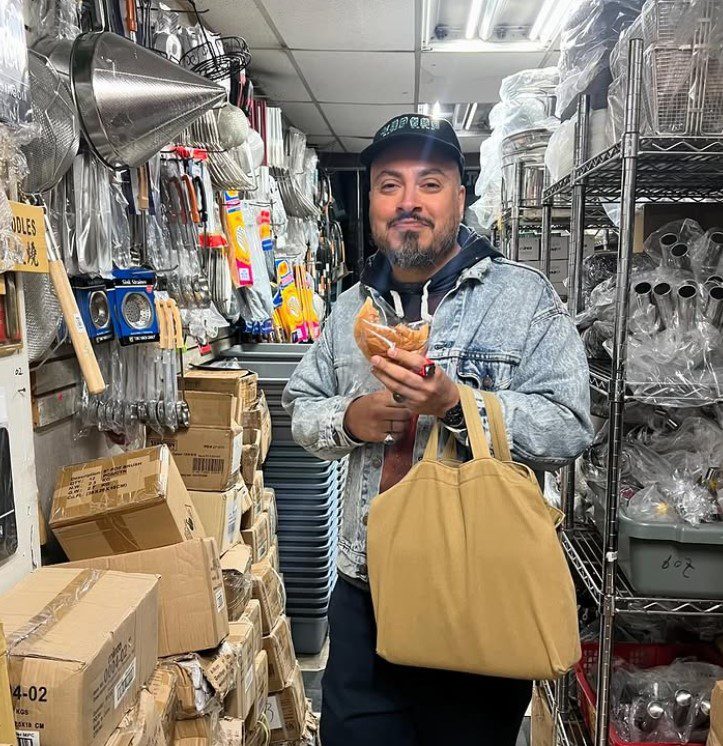 Arthur Pena (above), Below Grand, 53 Orchard St, NY.
Arthur Pena (above), Below Grand, 53 Orchard St, NY.
IM: How has being involved in this space influenced your own artistic practices? And how do you balance creative freedom with the practicalities of running a space?
AW: I really appreciate how much learning to work with 24 people to run something together has taught me as a human. I never thought I’d be a good listener, and I might still not be, but I’m so appreciative of what this insane sociality of the gallery requires of me to grow with. If there’s a conflict, you can’t be a part of escalating it. It doesn’t have much to do with my art practice, but I would say that I’m better at not externalizing my problems. I can’t imagine a scenario where I would be forced to learn how to listen and help and coordinate to the degree the gallery has required.
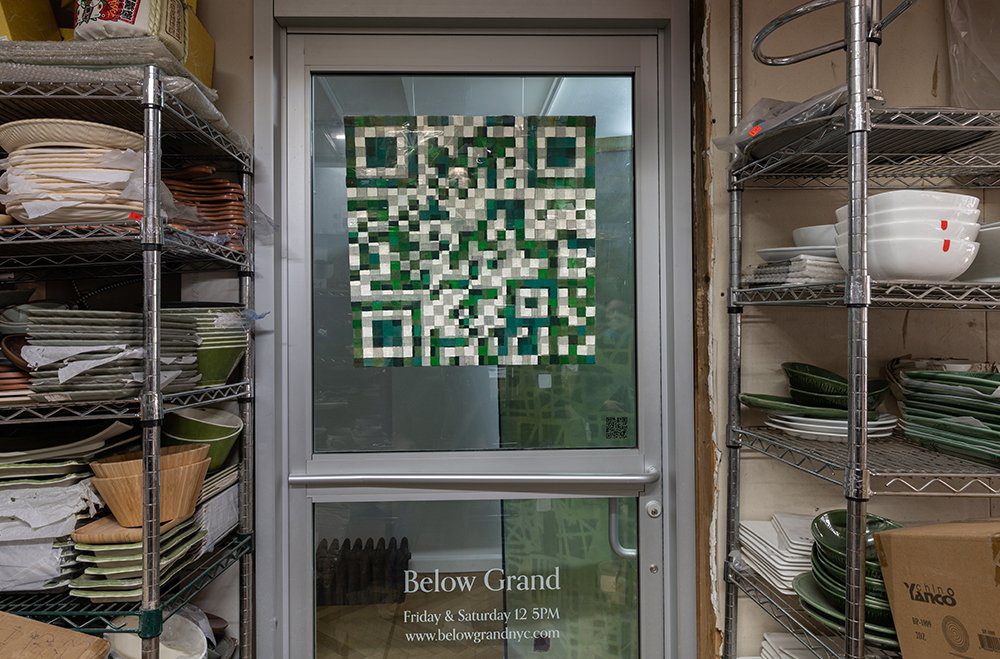 Installation view, Julia Rooney, Weather, 2024, Cyanotype on leather with oil and muslin 24 x 24 inches, Below Grand, NY.
Installation view, Julia Rooney, Weather, 2024, Cyanotype on leather with oil and muslin 24 x 24 inches, Below Grand, NY.
Marissa Graziano: All of the paperwork stuff can be learned, and it’s necessary to a degree, but it’s not the interesting part. When I’m working on a show, I start with the space – where a viewer enters, what it feels like once they’re inside, and how quickly I can make them want to leave. The space at 53 Orchard is really unique in this way. You can see it from all the way down the block, this bright monolithic cube that’s both a stage and a display case. The interior gallery performs in a completely different way. Its hidden entrance is inside of the kitchen supply store; very speak-easy. 52 Allen has a more traditional layout, but they each have an enormous amount of character and grit that can’t be ignored.
Artist-run galleries are always in the weirdest in-between spaces. They’re smaller and scrappier in NY for obvious reasons, but their strangeness encourages curation outside of the traditional ‘58 on center’ hang. You have to work with what you have, in a sense, and that can create surprising opportunities. You never know what’s behind a wall until you cut into it.
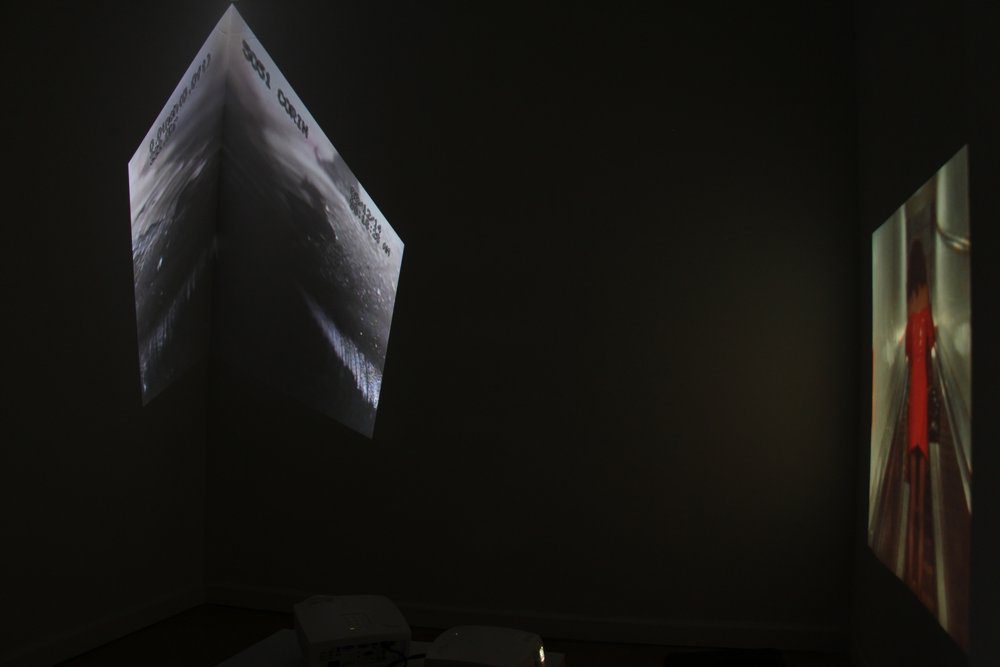 Ramp’s Edge, Ayanna Dozier, Won Ju Lim, Irini Miga, and Josh Rondeau, Curated by Marissa Graziano (above), Jan 18, 2025 – Feb 22, 2025, Below Grand, 53 Orchard St, NY.
Ramp’s Edge, Ayanna Dozier, Won Ju Lim, Irini Miga, and Josh Rondeau, Curated by Marissa Graziano (above), Jan 18, 2025 – Feb 22, 2025, Below Grand, 53 Orchard St, NY.
AS: Thinking as a curator allowed me to see my own work in a new way–to consider what it’s doing, or not, in relation to the current moment and the work of other artists that I’m excited by. When I first joined the gallery I thought, I would definitely not show my own work here. Which was a very productive and interesting realization. Now I’m bringing more of the world, and more research, into my paintings. Joining BG also expanded my idea of what it means to be an artist: how can I devote my life to aesthetics via my own practice and not participate in showing and sharing others’ work? The goal is more good art in the world, being made and being seen. And we cannot trust institutions, big galleries, or the markets (!) to be the arbiters of taste. So this is part of the practice now, curation. It similarly encouraged me to
start writing about art. We need each other.
IM: How do you see the role of artist-run spaces evolving in the future?
AW: Things may change, but it doesn’t look like things will ever go back to the way the market was before the ‘08 crash. It’s hard to imagine new collectors and patrons getting into this, and harder to imagine public funding, which is to say artist-run spaces could be the only thing left in 20 years. I hope I’m wrong. We are kept afloat because 24 of us split the rent which makes it affordable for us to do this and not curate through desperation. I would rather spend my time cultivating the knowledge that comes from investing in the care and concerns of the people around me, from the people that I need and we all need to keep this going, then try to figure out what might sell. Traditional galleries are important, and I hope there are enough incentives for new people to become gallerists. I like our model. We are peer-reviewed. We have an exhibition committee that weighs in on every show. It means that every show becomes an artist’s-artist show, and also expands past the idea of the authorship of the curator. The concept of the individual is killing all of us. Its unsustainable. I’m excited by what we’ve been curating since we’ve had this 24 person hive mind. Each show is more complex than any show any of us could have come up with on our own.
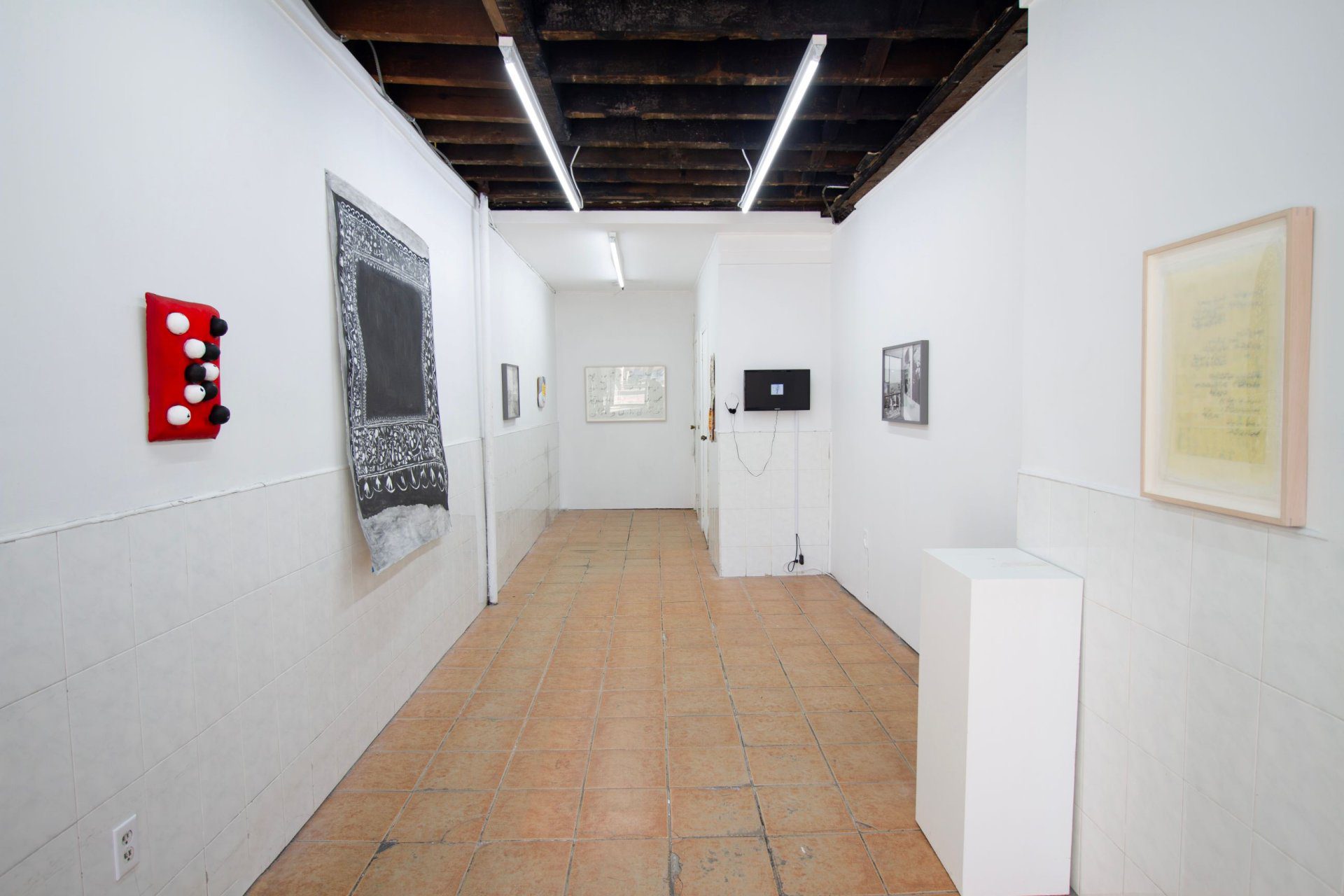 When one language licks another, Curated by Aparna Sarkar, March 1- April 5, 2025, Below Grand, 52 Allen St, NY.
When one language licks another, Curated by Aparna Sarkar, March 1- April 5, 2025, Below Grand, 52 Allen St, NY.
AS: I am interested in BG and similar curatorial collectives as one model of how to combat the extreme lack of diversity in galleries. Rent and overhead make it so you cannot keep a space in New York without proper financial backing; this class barrier is obviously intertwined with race and gender. Diversity of perspectives makes for higher quality in all work environments. I just want better, smarter shows that aren’t primarily about hawking wares. Splitting the rent 20 ways is one solution, becoming a non-profit is another. Either way, I hope to see more collectives take form.
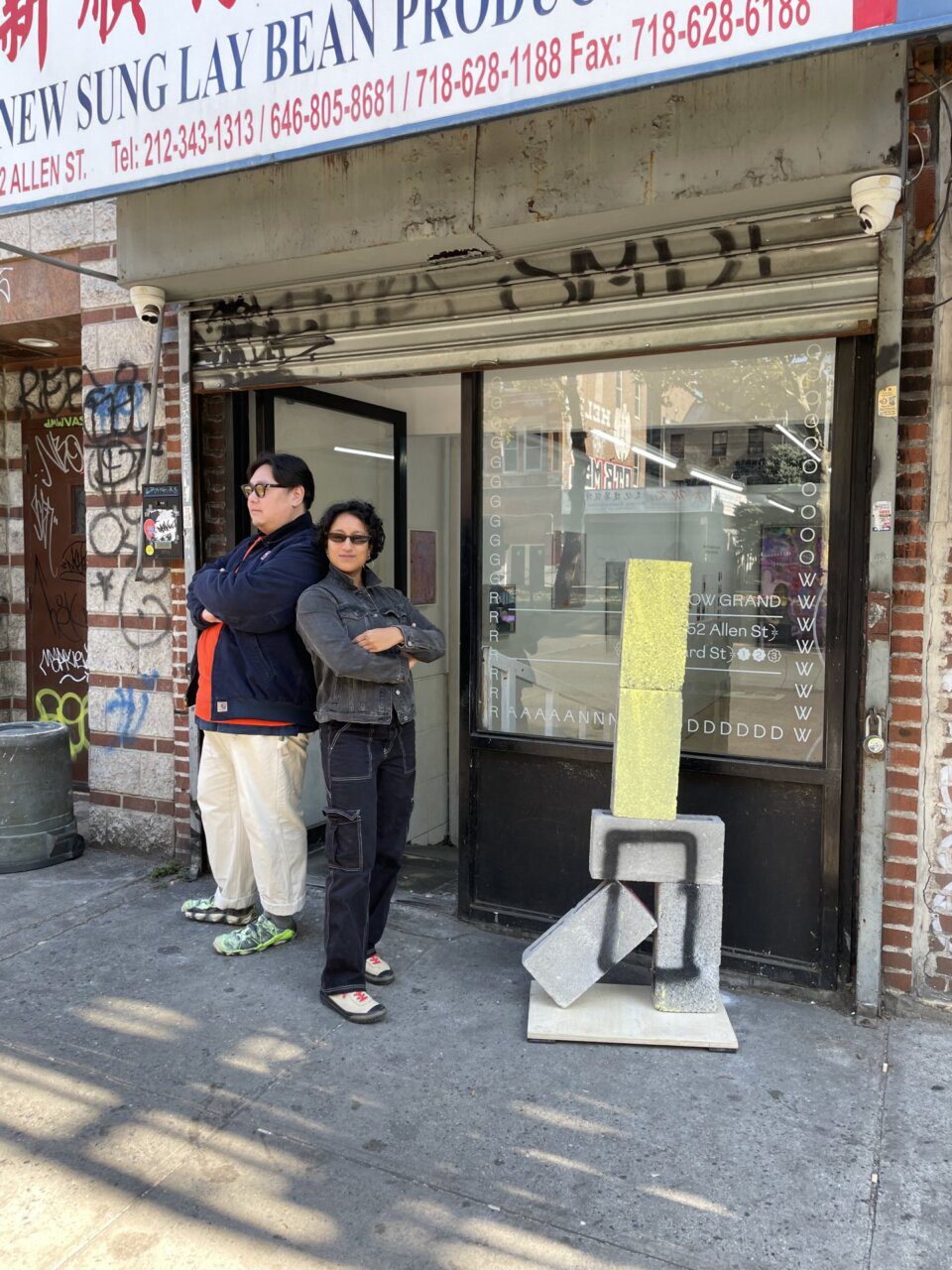 Wei Wang (left) and Aparna Sarkar (right), 53 Allen St, Below Grand, NY
Wei Wang (left) and Aparna Sarkar (right), 53 Allen St, Below Grand, NY
MG: These spaces are always around and always evolving. When I left Atlanta, I hosted a show in my empty apartment and when I came to the city, I started a project space out of my studio. The phrase ‘if you build it, they will come’ will always be true. It’s so much work to run a space and like Aparna said earlier, we all wear so many hats – it really does take a village. With twenty-four curators across three galleries, Below Grand is a testament to adaptability. And that starts before you, with people like Andrew and Mo who have been here since the beginning and built the program and reputation up to where it is today. It’s a labor of love that we owe to the members who have come before and will inevitably come after.
IM: Can you share a standout moment or exhibition that holds special significance for the space?
AW: Early on, showing Michael Jones McKean was incredible. I think he’s one of the best living sculptors. When I first started the gallery I wanted to show Molly Zuckerman-Hartung’s work. When she left her gallery, I heard through a friend that she wanted to do a show with us. 6 years after we started we showed her work and it ended up being our first review in the New York Times. It felt like it closed a loop. For me, it was rewarding for all kinds of reasons–– some of them poetic; but it also was patient. A lot of people start spaces and have 2 or 3 years of energy for them. Most people don’t picture year 6 or 7 or 8. It’s no longer brand new and fresh. It becomes a kind of debt you feel like you owe the people around you. You want to keep it going for all of the people who showed with you over the years and you want the gallery’s name to mean something for them and pay that back.
It also is important to me that a gallery extends cultural memory. The art world is pretty good at remembering the immediate present, the last two years, or 50 years ago. It has difficulty remembering 5-15 years. There are so many artists that contributed a lot to the scene or the community, and their names just aren’t being said right now for whatever reason. Below Grand has been a lot of different ideas of galleries by that point, and it all takes time in New York. The longer a gallery runs the more it’s expected to show visible growth.The city doesn’t know what to do with a gallery that doesn’t expand, but that’s more financial risk, which I associate with getting further and further away from taking care of the artists you work with. It becomes harder to expand cultural memory the more overhead you’re taking on. Also, the city is slow to let someone new in. It wants to see that things are here for the long haul and that’s something I’ve grown to appreciate. We’re conditioned to not appreciate stamina.
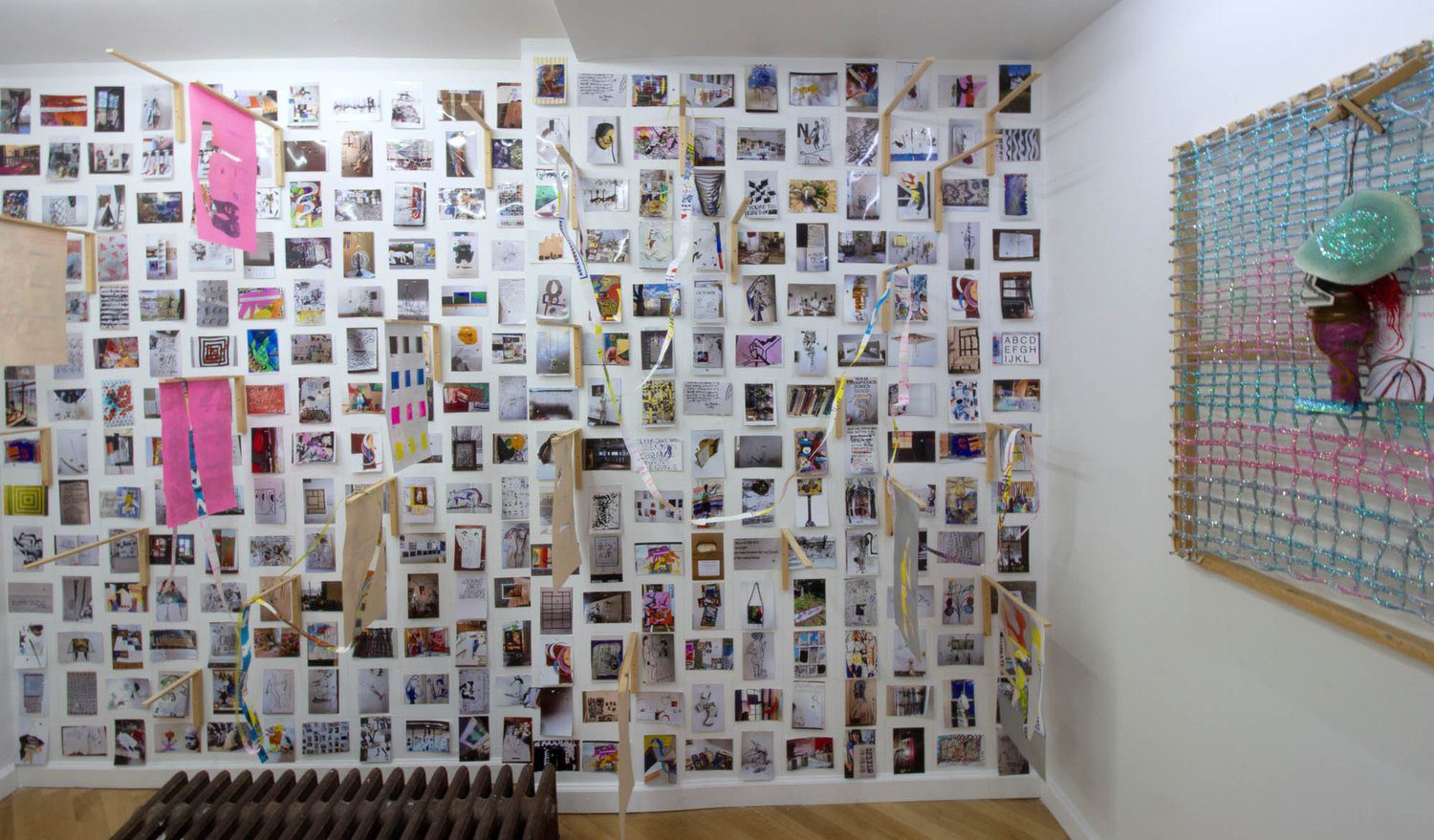 Menopause Recalls Puberty (M.R.P.), Molly Zuckerman-Hartung, Curated by Andrew Woolbright, July 13 – August 25, 2024, Below Grand, New York.
Menopause Recalls Puberty (M.R.P.), Molly Zuckerman-Hartung, Curated by Andrew Woolbright, July 13 – August 25, 2024, Below Grand, New York.
MK: Tess Bilhartz’ What On Earth was my first curatorial project with the Below Grand, her vision and ability to transfer the space into a totally different environment was really memorable. Joshua Miller’s Guts took over the in-store backdoor gallery, candles attached with his ceramic sculptures were the only light sources of the space, and we also organized 2 sessions of poetry reading in the dark. Christopher K. Ho and Alchemyverse’s exhibitions also happened during last year’s AAPI month, to gather the community, we hosted a breakfast hang outside the gallery space.
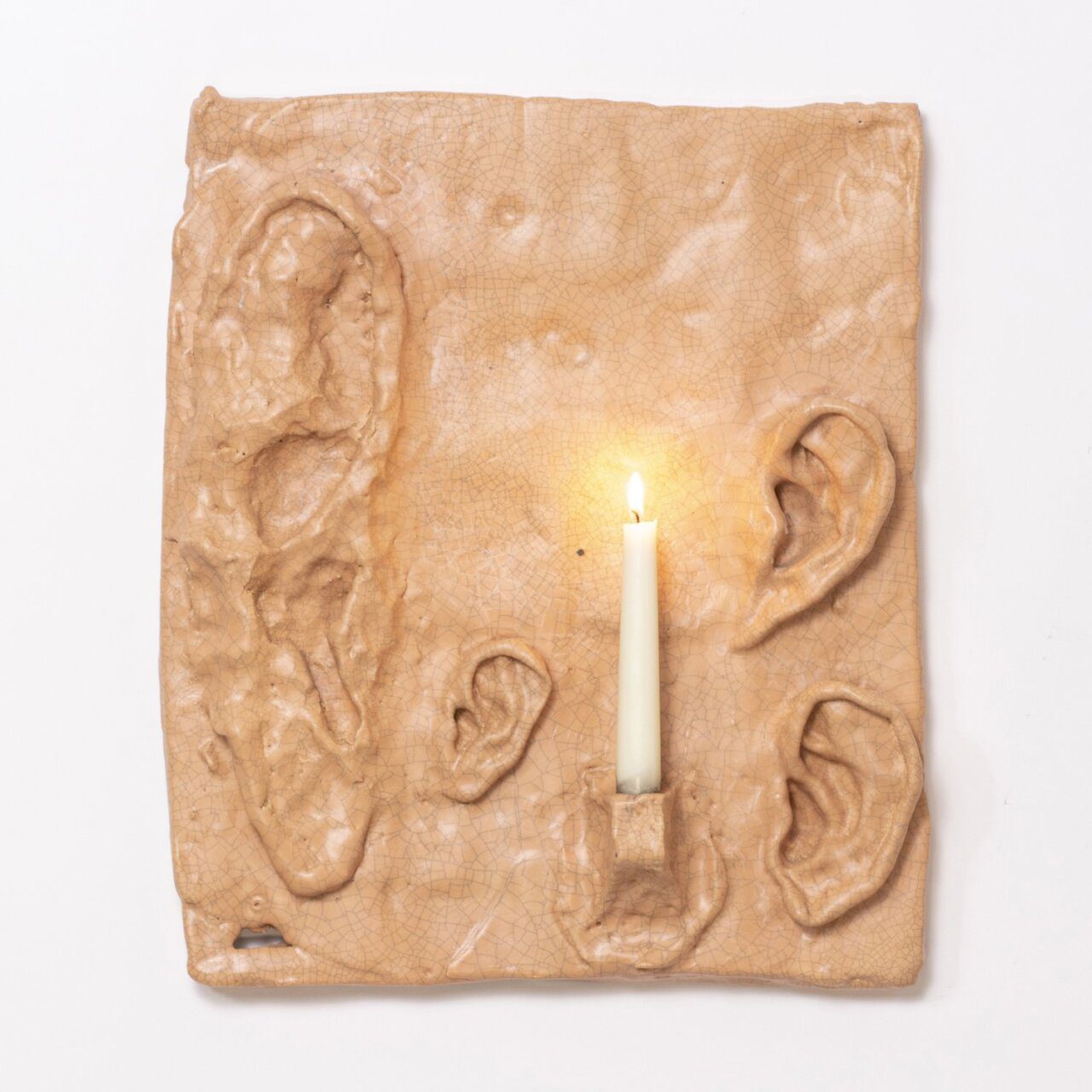 Gut, Joshua Miller, Curated by Mo Kong, November 26 – December 31, 2022, Below Grand, New York / Joshua Miller, Untitled, 2020, Glaze on ceramic, 18 x 15 x 2 inches
Gut, Joshua Miller, Curated by Mo Kong, November 26 – December 31, 2022, Below Grand, New York / Joshua Miller, Untitled, 2020, Glaze on ceramic, 18 x 15 x 2 inches
IM: What are some of your aspirations for the future?
AS: To engage with the history and legacy of Chinatown and the Lower East Side. To work with other galleries we admire in the area. To go hard and stay true.
AW: We just got to year 7. A gallery totally changes every couple years or they die. That being said, the next step in growth is how most galleries collapse. Consistency and endurance aren’t valued, but it’s more of what we truly owe each other. How do we do the most with the little that we have? How do we keep it together? I’m interested in new definitions of what a gallery can be, what the word gallery will mean in ten years. I’m interested in how it can be better used. It has to connect things together and remain open to that. I think the gallery needs to find a way to decentralize, to act as more of a hub or a spoke or something that distributes current in better ways. I think it needs to find a way to allow for research and study. I also think it needs to record more of what is around it, not just the art, but it needs to record the neighborhood as well. There are a lot of cultural forces that are actively erasing memory. That’s a fascist thing, a social media thing, but there are even some galleries that operate in a way that want to erase older artists by replacing them with someone copying them. I want our gallery to be committed to rebuilding memory––not just acknowledging the work of those that came before us, but also trying to preserve cultural memory, the memory of the Lower East Side, and give a space that allows for that. As Harald Szeeman said, “only the tribe survives.
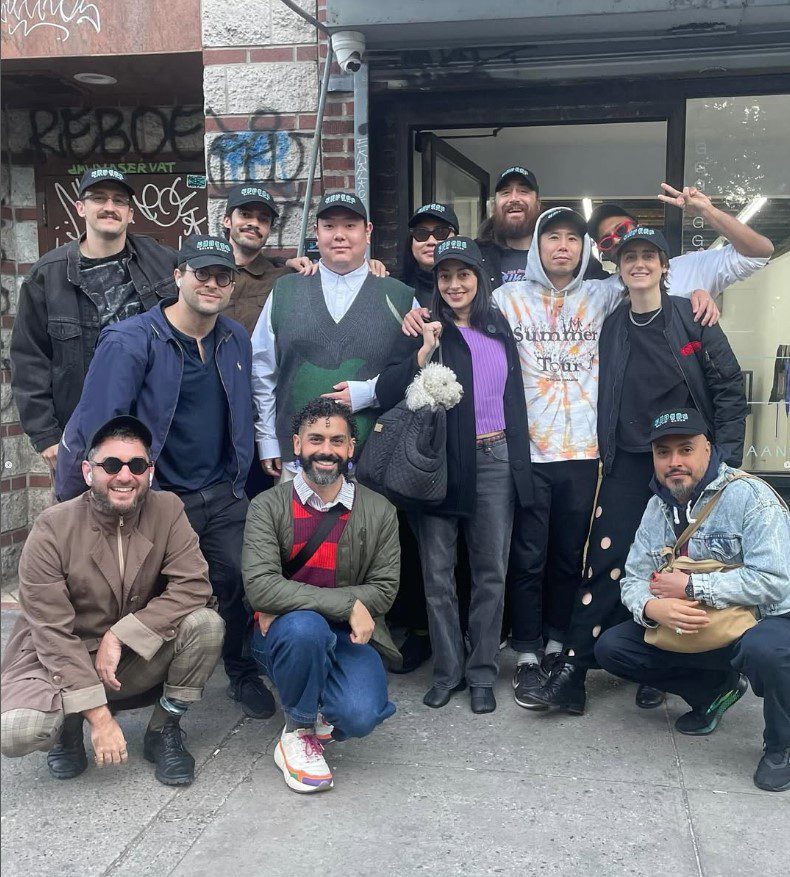 Curators, Below Grand (left to right): Til Will, Max Werner, Jesse Firestone, Nakai Falcon, Wei Wang, Mo Kong, Sarah Tortora, Andrew Woolbright, Ray Hwang, Zakariya Abdul-Qadir, Debbi Kenote, Arthur Peña
Curators, Below Grand (left to right): Til Will, Max Werner, Jesse Firestone, Nakai Falcon, Wei Wang, Mo Kong, Sarah Tortora, Andrew Woolbright, Ray Hwang, Zakariya Abdul-Qadir, Debbi Kenote, Arthur Peña
Below Grand is a commercial gallery and curatorial collective located at 53 Orchard St on the Lower East Side of New York. Steered by artists, the gallery aims to provide artists with an enriching gallery experience; one that builds solidarity, community, and safe harbor through its understanding of the stresses and material circumstances involved with engaging with the commercial art market. Below Grand’s ultimate goal is the development of a polyphonic, multivalent artistic community; with the intention of creating a horizontal structure of empowerment through the linking of multiple communities. Providing context through curation, the gallery is focused on introducing new artists to the New York art community while addressing imbalance through curation. Below Grand is passionate about curation as an act of discovery, recovery, and restoration with the understanding that curation is an act of identifying already present communities and building a visual counterculture.
Andrew Woolbright lives in Brooklyn, NY and is an MFA graduate from the Rhode Island School of Design. Woolbright was previously a resident at the Sharpe Walentas Studio Program and has recently exhibited with Anton Kern Gallery, New York (2025); Harkawik Gallery, New York (2024); Hesse Flatow, New York (2022); The Hole, New York (2021); Galerie Valeria Cetraro, Paris (2021); Zurcher Gallery, New York (2020); and Ada Gallery, Richmond (2020). His work has been reviewed in Artforum, TimeOut New York, ArtViewer, Two Coats of Paint, the Boston Globe, and the Chicago Reader, and his work is currently in the collection of the RISD Museum. In addition to exhibiting, he is Editor-at-Large at the Brooklyn Rail, and director of the gallery Below Grand on the Lower East Side. In 2024, he was awarded the Irving Sandler Prize, awarded to an artist that builds community as part of their artistic practice. He currently teaches at Pratt Institute and The School of Visual Arts in New York.
Mo Kong is an interdisciplinary artist, researcher and curator. They are currently residing in NYC. They received an MFA from the Rhode Island School of Design. They have been the subject of solo exhibitions at Queens Museum, Smack Mellon, CUE Art Foundation, Cuchifritos Gallery, Artericambi Gallery(Verona), Gertrude Gallery. Their work has been included in Queens Museum, RISD Museum, SFMOMA, Minnesota Street Project, Spring Break, ARTISSIMA, Make Room Gallery, Rubber Factory Gallery, Hesse Flatow Gallery and Island Gallery. They also received fellowship/residency from Sharpe Walentas , Macdowell Colony, Skowhegan, Triangle art association, The Drawing Center, City Artists Crops Grant, Mass Moca Studio, Vermont Studio Center, Lighthouse Works, and Artists Alliance LES Studio Program. They have been finalists of Artadia, Creative Capital, NYFA fellowship , and Van Lier fellowship.
Marco Tulio de la Sierra (b.1995) from Colombia, is a painter currently living and working in Brooklyn, New York. He received his BFA at SUNY New Paltz. His painting practice comes from time spent in the outdoors and a yearning to return to nature. As a byproduct of nature itself, there is an emphasis on nature mimicking itself; a fractal fractalizing. Marco has been a part of Below Grand for three years and has curated two group shows: Divine Reflections and Channels. He has exhibited at Putty’s Coronation, Below Grand, and Samuel Dorsky Museum.
Aparna Sarkar is an oil painter living in Brooklyn, NY. She holds an MFA in Painting from the Rhode Island School of Design (2021) and a BA in Mathematics from Pomona College (2014). Her work deals in pattern and ornament, often made from observation of Indian textiles and other made objects. Her practice also encompasses drawing, printmaking, and ceramics. She is a member of the curatorial collective and Manhattan gallery, Below Grand. For more information, visit aparnasarkar.us.
Marissa Graziano is an artist and curator from Atlanta, GA. She received her MFA in Painting from Boston University in 2018. She creates paintings, videos, and installations that lure and leer at her audience to provoke paranoia. In 2019, she co-founded Greene House Gallery with her partner, Samuel Guy, out of their home in Fort Greene, Brooklyn. They expanded the project in 2023 to include GH mag, an independent online publication featuring artist-written reviews, interviews, and essays. She joined Below Grand in 2024.
Irini Miga is an interdisciplinary artist currently based in Athens, Greece. She has been a contributing editor and team member of Daily Lazy since 2015.


